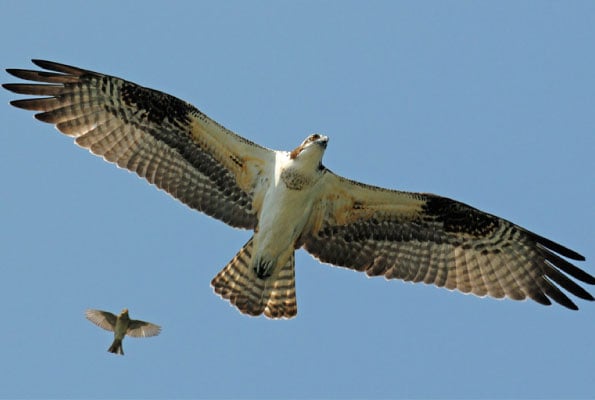Prime
How degradation is driving migrant birds out of Uganda

The Osprey seen near Entebbe International Airport in 2016. It is believed the bird had flown from Finland. PHOTO/COURTESY
What you need to know:
- Birds migrate to avoid conditions that threaten their survival.
- Threats such as habitat loss, degradation caused by agriculture and infrastructure development are some of the biggest threats to bird migration.
- Experts want degraded ecosystem to be restored.
Paul Turyagumanawe, a seasoned birder, is the head guide at Apes Birding Eco-Tours, a highland forest birding company in East Africa. He recently added the Ortolan Bunting, a migratory bird, to Uganda’s checklist. On his mind, is a question of when migrant birds will no longer make stopovers in Uganda, due to the ongoing human-induced environmental degradation.
When the winter season hits the northern hemisphere in June, July, and August, mammoth varieties of birds migrate southwards.The birds follow suitable habitats, where they can stop to rest and refuel along the way.
On their way, migrant birds from Europe use the African-Eurasian Flyway, the three flyways that connect Europe and northern Asia with Mediterranean, Middle East, and Africa and one of the areas they use as stop overs and end up staying, is Uganda.
Turyagumanawe says when migrant birds arrive in Uganda, they find a good resting place and end up not going back or continuing, though they fly without borders.
“Not all the birds from Europe and Asia migrate. Just a few. Some stay home, and adapt to the tough life. The best will travel down to the evergreen paradises of the world,” he says
Crammy Wanyama, a birding guide at Avian Safaris says the birds migrate after their food and habitats have been covered by snow in the northern hemisphere. By moving southwards, they are looking for better places for survival.
Magical movement
According to Birdlife International, “Different bird species share broadly similar routes, which have been loosely split into eight major flyways – think of them as bird super-highways across the sky.” Turyagumanawe says when birds start out on the journey, they are guided by geographical features such as the positions of mountains, seas and even lakes.
“They know the positions of the stars relative to their flyways because most birds fly at night. They land to feed during the day. They know how to avoid deserts such as the Sahara and the Mediterranean Sea. This ensures their survival and timely arrival,” he says
In her August 19, 2016 story, Uganda, hub for birds on the move, Gillian Nantume reported that the peninsula of Entebbe, located on the Asian-East African flyway, a migratory path of birds moving from the northern to the southern hemisphere, is a favourite resting place for the birds. Entebbe is an important area for migratory birds.
In the next month or so, some birds will eat up to twice their body size. Some will shrink their gizzards and some will become highly sociable, in order to find flying parties for their annual migration. Around October, these birds, having flown down to Africa, will start arriving in Uganda. They include raptors, bee-eaters, warblers, wagtails, water birds and even the fancy rollers. There are also intra-African migrants, the birds that fly west to east, or south to north, within Africa.
Survival threatened
As birds migrate, they avoid conditions that threaten their survival. Threats such as habitat loss and degradation caused by agriculture and human infrastructure development are obstacles to their travelling flyways. “Runaway agricultural activities, destruction of forests, such as an attempt on Mabira, and now Budongo, are big threats too. These are changing the landscape, making it unrecognisable for the migrating birds. Power lines are also another challenge,” he says.
Davis Rukundo, the chairperson Bird Guides Club, says the bird population has fostered tourism. Food and favourable conditions keep the birds around, but threats have continued to narrow the space. “What is keeping many migrant birds here, is mainly food. These numbers keep reducing because their habitats are destroyed,” said Rukundo.
According to United Nations Environment Programme, approximately 2,000 of the 11,000 bird species in the world travel thousands of kilometers to find the best conditions and habitats. However, currently, 14 percent of the world’s bird species are endangered.
Over the past 30 years, the number of migratory birds has almost halved, since they are at greatest risk during the migration season, so the survival rate of their chicks is rapidly decreasing.
Wetland encroachment
Migrant birds use wetlands as migration service-stations. Wetlands are the preferred point of many migratory birds. They host a variety of aquatic plants and animals and provide nourishment and lodging for the exhausted birds.
Wetland mapping exercises undertaken in 1994 and 2015, indiacte that wetland coverage declined from 15.6 percent in 1994 to 8.9 percent in 2021. Augmented habitat loss in the last two decades, including swamplands, natural plains and forests,are major impedements for the migratory birds.
Destruction of bionetworks, habitat in places of stops and plundering, collisions with artificial objects in large cities, as well as power lines are a common cause of death of birds. “Where I live, the wetland cover has been so degraded that I have to travel to Ankole to find genuine wetlands for the water birds. Our own Lake Bunyonyi (of the little birds) has been so hemmed in that the farmers dig to its very shores,” says Turyagumanawe.
Worldwide Wildlife Fund for Nature-Uganda Country Office Wildlife and Protected Areas manager, Daniel Ndizihiwe highlights continued habitat loss as a top threat for migrant birds.
“As degradation of habitats continues, the birds will shift to other favourable areas. This leads to a shift in tourism activities, because tourists will look for the birds where they are,” Ndizihiwe says.
Call for action
Wanyama appeals to government to sensitise communities on the benefits of wetland conservation and provide alternative livelihood options to the people. “People need information on how conservation can benefit them and how birds contribute to their welfare through tourism,” he adds.
Restoration of the degraded ecosystem, protection of the places where birds live and travel through, and bringing deforestation to an end is a powerful tool that will make the migrant birds keep coming to Uganda.
What the government says
Bashir Hangi, the public relations manager at Uganda Wildlife Authority (UWA), says while their mandate is to protect wildlife, they cannot stop the migrating birds from leaving Uganda.
“Migrant birds, as the name suggests, do not stay in Uganda all the time. UWA does not hold any animals in captivity, so they have a right to move as and when they wish to do so. Our job is to ensure thatbirds in our protected areas find a suitable habitat. This explains why migrant birds keep coming to specifically along the Kazinga Channel in Queen Elizabeth national Park,” Hangi says.





